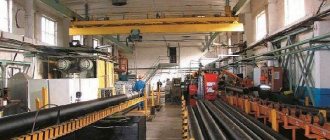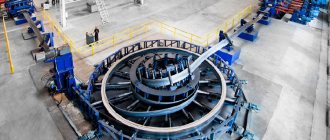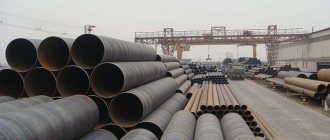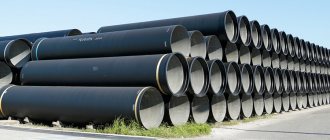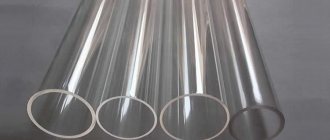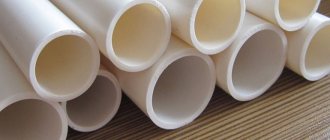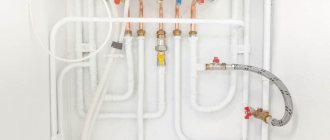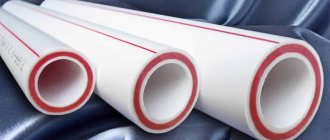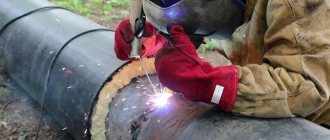offers to buy equipment for the production of polypropylene and polyethylene pipes of various types - profile, round, etc. We will design, deliver, install and configure a pipe line in Moscow or another city in Russia. We provide a guarantee for the equipment.
- What is a “mixer” for?
A mixer is necessary for mixing raw materials with different bulk densities. During the mixing process, the raw materials are mixed and evenly distributed inside the mixer.
- Why do you need a raw material autoloader?
It transports raw materials from the Mixer to the Extruder. This eliminates the factor of raw material spillage and reduces the work of the pipe line operator. The autoloader is programmed and supplies raw materials in the required quantity after a certain period of time.
- Why is a drying hopper needed?
The drying hopper allows you to dry raw materials, “crushing”, “agglomerator” and other materials if they are wet or damp. This further affects the quality of the pipe.
- What is the production principle of plastic pipe (extruder)?
The pipe is produced, like many other PE products, by extrusion. This means that the material enters the screw, where it is mixed under the influence of temperature and rotation of the screw, then filtered through a filter mesh, and fed into the extrusion head, where it takes on the desired shape.
- How is the pipe diameter determined?
With the help of a mandrel, a matrix, this is located in the extrusion head. And the calibrator is a receiver that is located at the beginning of the vacuum bath. And takes a pipe from his head into the bath.
- Co-extruder, what is it for?
It is used to apply stripes to the walls of pipes 1 or 4 according to the customer's choice. There are 2 holes in the extrusion head for this. If you connect the co-extruder on one side, there will be 1 strip. If on the other hand then 4.
- Where does the vacuum come from in a vacuum bath? And how is the pipe formed?
Inside the vacuum bath, there is a pipe with a large number of slots, 1-0.5 mm wide, through these slots and the wall of the bath itself, a vacuum is created due to the vacuum pump, so the pipe (product) is constantly pressed against the notched pipe inside the vacuum bath.
- Cooling bath, what is it for?
It is installed on large diameter or high-performance pipe lines. If the pipe does not have time to cool in a vacuum bath, then in this case a cooling bath is required, where cold water is supplied using a large number of nozzles and cools the plastic pipe.
- Pulling device, what is it for?
Pulls the pipe from the extrusion head to the cutting device. In the event of a start-up or breakage, for start-up it is necessary to leave the so-called “Start-up pipe”, it goes from the extrusion head, where a new hot pipe is attached to it, to the pulling device. This allows you to start up this equipment faster.
- How does the cutting device work?
The cutting device has a clamp and a “saw”; they move in the direction of movement of the pipe. The clamp holds the pipe and moves with the pipe, at this moment the saw cuts the pipe. Next, the pipe is wound onto a winder, or folded onto a pipe layer.
- Winding device, what is it for?
It is designed for winding pipes. The maximum diameter of the pipe winder is up to 110. Winding above is not carried out. Diameters above 110 are cut into straight pieces of pipe and laid on a pipe layer.
- How is the wall thickness set?
The wall thickness is set by the feed of the mass of material by the screw and the extraction speed. The higher the feed and the slower the exhaust, the thicker the pipe wall and vice versa.
- Why is the wall inside the pipe not smooth?
Often this problem is associated with poor quality of raw materials; due to different PTR, the wall begins to “walk”. Or due to a worn auger. The screw does not mix raw materials with additives (chalk, recycled materials), so at the outlet the pipe may have an uneven inner wall.
- Can PE pipe line produce PP pipe?
Maybe - this requires adjustment of the extrusion head and in rare cases depends on the capabilities of the equipment. Therefore, it is recommended to check the information with the manufacturer for PP.
- What is SDR?
The marking of polyethylene pipes always includes the SDR parameter. This is a GOST requirement. An example of pipe marking according to GOST:
Pipe PE 32 SDR 21-32 Drinking GOST 18599-2001
GOST 18599-2001 tells us:
3.7 Standard dimensional ratio SDR: The ratio of the nominal outside diameter of the pipe d to the nominal wall thickness e.
What is SDR?
SDR (from English Standard Dimension Ratio - standard dimensional ratio) is a characteristic of a polymer pipe, which is the result of the ratio of the outer diameter of the pipe to the wall thickness.
This value is inversely proportional to the thickness of the pipe walls, that is, products with thin walls have a higher SDR index, and vice versa - a pipe with a thick wall has a lower SDR.
Pipes with the same outer diameter but different SDR will have different wall thicknesses. The SDR indicates not only the wall thickness, but also the capabilities of that pipe. Pipes with a lower SDR can withstand greater loads and pressures.
Today pipes with SDR from 6 to 41 are produced.
Table. "Pressure class"
| SDR 6 | SDR 7.4 | SDR 9 | SDR 11 | SDR 13.6 | SDR 17 | SDR 17.6 | SDR 21 | SDR 26 | SDR 33 | SDR 41 |
| 25 atm | 20 atm | 16 atm | 12 atm | 10 atm | 8 atm | 7 atm | 6 atm | 5 atm | 4 atm | 4 atm |
Staff
Each production line must be serviced by two or three operators. It is also necessary to include a technologist, general workers and a manager in the company’s staffing table.
Salaries should be based on the average tariffs in force in the region. As a rule, the salary of a manager is set in the region of 50-70 thousand rubles, a technologist - 40-50 thousand, a production line operator - 25-30 thousand rubles.
PVC pipe production line personnel
If the company operates in shifts, it will be necessary to hire several work teams that will work on schedule. Here you need to remember that it is not enough to form a team, you also need to maintain it. To do this, it will be necessary to provide employees with social guarantees, ensure normal working conditions and develop an incentive system.
Commercial offer
Extrusion line for the production of PE pipes with a diameter from 63 to 160 mm.
We are pleased to present to you extrusion lines made according to the instructions of our company’s engineers. In the formation of these lines, many years of experience in working with Russian raw materials - primary and secondary, working and operating conditions were taken into account. All components are easily replaceable and repairable. Extruder units allow for maximum productivity on various types and diameters of pipes. Almost all electronic components used are European, the main components are made of high-quality metals, which ensures long-term operation of the equipment. The low cost is due to assembly in China, at a factory that has CE quality certificates and its own design developments. Almost all extruder components are manufactured at this plant, which makes it possible to guarantee full warranty coverage. Our company offers selection, installation, installation and training on equipment for the production of plastic pipes (PVC, HDPE). We provide full warranty support for 12 months from the date of commissioning of the line and post-warranty service.
Market analysis
Over the past five years, the Russian plastic pipe market has grown significantly in volume. At the end of 2021, supplies of PVC products compared to the previous year, 2021, increased by 4.7%, amounting to 617.8 thousand tons of finished products. The leading supplier of plastic pipes and fittings is the central region of Russia: Rostov region - 32.1% of the total volume of finished products; Moscow – 20.12%; Moscow region - 15.39%.
PVC pipes made in Russia are in high demand not only in the domestic market.
The main consumer country of plastic products from the Russian Federation is Belarus, where about 25% of all goods produced were exported in 2021.
Also, PVC pipes are exported by Russian brands to Kazakhstan, Ukraine, Uzbekistan and Lithuania. In general, products worth a total of $110.77 million were exported to these countries.
Today, the average selling price for PVC pipes for the domestic market is 104 rubles per kilogram.
Line equipment:
| 1 | Raw material autoloader | 1 kit |
| 2 | Raw material drying bunker 100kg | 1 kit |
| 3 | Single screw extruder, Ф 75 mm | 1 kit |
| 4 | Co-extruder 25/25 | 1 kit |
| 5 | Forming device | 1 kit |
| 6 | Calibration device and cooling bath | 1 kit |
| 7 | Cooling bath | 1 kit |
| 8 | Receiver | 1 kit |
| 9 | Printer | 1 kit |
| 10 | Automatic cutting device | 1 kit |
| 11 | Pipelayer | 1 kit |
Investments and profitability of this business
To effectively start a business producing HDPE pipes, you will need at least 9 million rubles or 140 thousand dollars. This amount already includes funds for the purchase of equipment, paperwork and permits, renovation of premises, employee salaries and raw material costs for 6 months, rent, utility bills, tax deductions and expenses for promoting the new brand.
The success of any production activity is based on many factors, including the presence of consumers and suppliers of raw materials in close proximity, product range, the effectiveness of the chosen advertising strategy, and others.
As for the cost of the final product, it depends on the type and dimensions of the products.
Raw material dryer hopper
| Capacity | 315 liters |
| Fan | 0.37 kW |
| Heaters | 15 kW |
| Performance | 200 kg/h |
| Material | 304 stainless steel |
Cooperation and advertising
Every modern city has its own suppliers of plastic pipes. To win the competition, it is necessary to enter into profitable cooperation. You need to offer your product to companies that install plastic pipes or to hardware stores. This way you will provide yourself with regular customers. Naturally, you will have to make some concessions in order to obtain profitable cooperation.
All possible bonuses and discounts must be developed in advance during the process of drawing up a business plan. Particular attention should be paid to promotions. They are necessary not only at the beginning of the company’s existence, but throughout its entire activity. This is where advertising banners around the city, leaflets, announcements and other means come to the rescue. Don't forget about the possibilities of the World Wide Web.
Single screw extruder, model RS-75/30
| Extrusion Capacity | 220-280 kg/h |
| Diameter | 75 mm |
| L/D ratio | 33:1 |
| Screw material | 38CrMoAl |
| Screw surface treatment | Nitriding, polishing |
| Nitration depth | 0.4 – 0.7 mm |
| Maximum rotation speed | 150 rpm |
| Cylinder material | 38CrMoAl |
| Screw surface treatment | Nitriding |
| Nitration depth | 0.4 – 0.7 mm |
| Number of heating zones | 5 |
| Heater power | 22.5 kW (total) |
| Cooling type | Water/air |
| Cooling fans | 0.37 kW x 4 |
| Gearbox | Transmission - gear Low noise level Shaft: NSK Japan Movement material: 20CrMnTi Brand: made by Guomao |
| Drive motor | 90 kW |
| Extruder Components | Frequency converter: Delta brand AC Contactor: Schneider Switch: Schneider Electrical relay: Schneider Temperature controller: RKC, Japan |
Distinctive features of polypropylene products
The popularity of such products is explained by many reasons, among which the positive characteristics of polypropylene are of primary importance:
- Polypropylene parts are highly durable.
- The material does not rust or rot.
- Polypropylene can withstand large temperature changes.
- Does not affect the quality and taste of water.
- Has a very long service life.
- It is significantly lighter in weight compared to metal counterparts.
- Lower cost due to simple manufacturing method.
Coextruder, model RS-25/25
| Extrusion Capacity | 1.5 -10 kg/h |
| Diameter | 25 mm |
| L/D ratio | 25:1 |
| Screw material | 38CrMoAl |
| Screw surface treatment | Nitriding, polishing |
| Nitration depth | 0.4 – 0.7 mm |
| Cylinder material | 38CrMoAl |
| Screw surface treatment | Nitriding |
| Nitration depth | 0.4 – 0.7 mm |
| Number of heating zones | 2 |
| Cooling type | Air |
| Cooling fans | 2 |
| Drive motor | 1.5 kW |
| Extruder Components | Frequency converter: "ABB" / "Delta" Temperature controllers: "RKC" |
The production process of polyethylene pipes
The technology for the production of polyethylene pipes, which uses the extrusion method, is implemented on non-stop closed conveyors. The entire process includes the following steps:
- The granules coming from the accumulation hopper into the extruder undergo a melting process. Next, the screw feeds the viscous mass into the extrusion head.
- The extruder head creates high pressure, which allows the product to be given the desired size and shape, for which hot molten mass is used.
- Next, the formed workpiece is sent to the area where vacuum calibration occurs, where greater accuracy is imparted to the pipe diameter. At this stage the product is also partially cooled.
- At the next stage, according to the technological process, the pipe undergoes a process of complete temperature normalization, for which special cooling baths are used.
- The production of polyethylene pipes is completed by cutting the finished pipe blank into pieces of the required length using a special planetary saw.
- Subsequently, the finished product undergoes appropriate labeling and storage on racks, with subsequent removal to sales or storage points.
A logical controller is called upon to monitor the correct observance of all the necessary nuances of the technology used to manufacture HDPE pipes. If any malfunction or violation of established production conditions is detected, this person must immediately stop the entire process and notify the operator.
Forming device, diameters from 63 to 160.
| Forming device | 1 kit |
| Wall thickness | SDR26, SDR17, SDR11 |
| Diameter range | Ф 63mm, 75mm, 90mm, 110mm, 160mm, |
| Forming device material | 40Cr, polished inner surface |
| Calibrator Bushing Material | Copper/tin/bronze |
Manufacturing technology
Fundamentally, the technological process of molding polyethylene and polypropylene pipes from recycled material at factories is not much different from their production from primary raw materials.
The main difference lies in the stage of preparing polymer waste and bringing it to a form convenient for further extrusion.
Next, we will consider all the stages of the technological process for the production of polymer pipes and fittings from recycled plastic, the equipment that will be needed at each stage, and we will also pay special attention to some particularly important points.
Production stages and necessary equipment
The main stages of the technological process are :
- Preparation of secondary raw materials. Used plastic products must be cleaned of contaminants, sorted and crushed. Grading perhaps plays the most important role in determining the quality factor of the finished pipe, since a uniform material will be stronger and more durable. The equipment you will need is: a crusher, a flotation and hydrocyclone washing line, and a dryer.
- Waste granulation. When producing molded products, this stage cannot be avoided. It is almost impossible to work with crushed material during direct pipe extrusion, because the design of the screw on a pipe extruder does not imply work with a heterogeneous fraction of raw materials. Granulation has another advantage - the ability to introduce several technological additives into the composition (stabilizers, chalk and dyes).
- Pipe extrusion is the final stage of production. To form a pipe, you need a single-screw extruder equipped with a die of the appropriate profile, as well as a calibrator and other auxiliary equipment. Some European device manufacturers offer machines designed to work with different types of raw materials (i.e. for recycled plastic too), but they are quite expensive.
Extrusion Process
In this section I would like to focus on the key points that, when working with recycled plastic, will directly affect the quality of the finished pipe.
In order for the process to be reproducible, the following rules must be followed :
- Use the most homogeneous raw materials. This is perhaps the most important recommendation. Sorting waste according to plastic composition will help prevent the finished pipe from being rejected.
- Dry the crushed grain. The plastic, crushed and washed from contamination, must be dried to eliminate defects in pore formation in the pipe.
- Use a vacuum. At all stages of both granulation and extrusion, a vacuum is required. This way it will be possible to obtain a uniform pipe wall without jumps in thickness.
- Use melt filtration mesh. Plastic waste contains a lot of foreign matter that needs to be sifted out.
- Select supplements. It is problematic to create a good product using pure recovered polymer. Here you cannot do without heat stabilizers and antioxidants; a light stabilizer may also be required (if you plan to use it under the sun).
Vacuum forming cooling bath
| Vacuum forming system | |
| Water cooling system | |
| Water level control system | |
| Water temperature control system | |
| Length | 6000 mm |
| Bath material | SUS304 steel |
| Filter | Tin-Bronze |
| Cooling method | Spray filler |
| Water pump power | 4kW*1 |
| Vacuum pump power | 3kW*1 |
| Vacuum degree | 0.03 – 0.06 MPa |
| Adjustments | |
| Back and forth | +/- 600mm (Servomotor) |
| Up down | +/- 50mm (Manual control) |
Why is it profitable to produce polypropylene pipes?
The widespread use of polypropylene pipes in pipelines for various purposes is caused by a number of parameters that are beneficial for each consumer:
- polypropylene pipes are very durable;
- impossibility of rust or rot;
- resistance to temperature fluctuations;
- the material does not react with water, therefore without affecting its taste;
- high performance characteristics (the service life of polypropylene pipes significantly exceeds that of steel pipes);
- low weight of products;
- low cost of polypropylene pipes and connecting fittings.
Read material on the topic: Wholesale of polypropylene pipes
Cooling bath
| Water cooling system | |
| Water level control system | |
| Length | 6000 mm |
| Bath material | |
| Frame | SUS304 steel |
| Cooling method | Spray filler |
| Water pump power | 3kW*1 |
| Up down | +/- 50mm (Manual control) |
| Elktronika | Made in Japan |
Types of equipment for manufacturing
Equipment for the production of polypropylene pipes (exruders) are machines of the following types:
- Screw. They function similar to a juicer or meat grinder.
- Screwless. They are used to produce blanks from mixed materials. The main part in these mechanisms is the disk.
- Combined. In these mechanisms, the screw part is combined with a disk.
IMPORTANT! The screw type of machine is considered the most common equipment for the production of plastic products.
In addition to the extruder, lines for the production of plastic pipes also have the following equipment:
- Raw material supply system.
- A machine that cuts blanks.
- Container for calibrations and cooling.
- Pulling mechanism.
- Mixer.
- Conveying tape.
- Vacuum forming.
- An accumulating mechanism that stacks workpieces.
Receiver
| Length | 1400 mm |
| Conveyor width | 190mm |
| Clamp | Pneumatic |
| Feed speed | Using a frequency generator |
| Engine traction power | 1.5 kW * 2 |
| Feed speed | 3.5-8 m/min |
How PE pipes are transported and stored
Recommendations for transportation and storage of pipes:
- Any vehicle that meets the required standards is suitable for transporting pipes.
- If polyethylene pipes are transported in covered railway cars, a certain limit of 1.25 tons is established for bags, coils or coils used to store pipes up to 5.5 m in length.
- If water transport is used for transportation, it is best to use special bags for packaging products.
- For laying polyethylene pipes of heating, water supply and sewer type, any flat plane that does not have sharp corners that could damage the products is suitable.
- When storing polyethylene pipes, standards 5 (OZh4) of section 10 of GOST 15150 must be observed. If the storage time of products does not exceed one year, you can rely on conditions 8 (OZh3). This period also includes the time during which the products were with the manufacturer. As experts recommend, it is better not to make stacks for storing pipes for more than 2 months higher than 200 cm. If storage will continue for no more than 2 months, the height of the stack can be increased to 300 cm.
The market is flooded with polyethylene pipes from different manufacturers, which places special demands on the process of selecting a suitable product: this is especially true for products manufactured in our country or in China. When purchasing, you should check for a quality certificate and conduct a thorough visual inspection of the purchased product to ensure there are no visible manufacturing defects. This can serve as a guarantee of the service life declared by the manufacturer.
Cutting device
| Length counter for cutting | Auto |
| Cutting pipe diameter | 63-160mm |
| Synchronization of cutting and broaching | Automatic |
| Engine power | 2.2 kW |
| Maximum cutting thickness | 22mm |
| Maximum feed speed | 8m/min |
How PE pipes are prepared before and after production
Quality control
In addition to equipment for the production of polyethylene pipes, the workshop has end-to-end quality control of products. To carry out incoming inspection, raw materials for the production of polyethylene pipes must have accompanying documentation - a passport and quality certificates. As the production process progresses, the line operator monitors the quality of the product: for these purposes, he has measuring instruments. Each batch of finished products is checked by the technical control service for suitability, in accordance with GOST.
Mixer
| Model | TVM-500 |
| Power | 4 kW |
| Network connection | 3phase/380V 50Hz |
| Load capacity | 500 l |
| Dimensions(mm) | 1500x1500x1750 |
| Weight | 750 kg |
| Cost including VAT 18% | 6310 USD |
Organization of a production workshop
It is optimal if the production facility is located in an industrial zone or outside the city limits. When choosing a location, it is necessary to take into account factors of transport accessibility and the availability of high-quality access roads. To organize production, you will need a structure with an area of 200 m², a ceiling height of at least 10 m with an electrical network (380 V), water supply and drainage systems.
The interior of the building should be divided into several zones:
- manufacturing facility;
- areas for storing raw materials and finished products;
- WC;
- premises for employees.
Given the large dimensions and high level of heat production during the production process, the workshop must be equipped with powerful air conditioners and a modern fire protection system. Warehouses will require the installation of a heating system to maintain positive temperatures in winter.
Chiller
| Model | RSAU10D |
| Cooling capacity | 53320 kcal/h |
| Maximum power consumption | 20 kW |
| Compressor | 7.93 kW |
| Freon volume R407C | 6,5*2 |
| Cooling Fan | 1.01*2 kW |
| Total air flow for chiller cooling | 20000 |
| Water tank volume | 180 l |
| Inlet and outlet pipe diameter | 2-1/2 inches |
| Pump | 1.5 kW |
| Dimensions (L*W*H) | 1750mm*1100mm*1900mm |
| Weight | 590 kg |
| Cost including VAT 18% | 12420 USD |
Recruitment
To organize the uninterrupted operation of the enterprise in two shifts, you will need to hire at least 6 workers (3 people per shift), an accountant, a process engineer, two operators servicing the operation of the machines, as well as several auxiliary workers and at least two security guards. On average, the cost of paying a team requires $6,000.
The production of HDPE pipes is classified as technically complex. This means that to open a business you will need to obtain permits from the local administration, State Energy Supervision Authority, Sanitary and Epidemiological Station, and the fire inspectorate. The priority form of enterprise registration is LLC.
Crusher
| Model | TGP-6032F |
| Type of material processed | PET, PET, PE, PP, ABC, PVC, PS, PC, LDPE |
| Power | 15 kW |
| Network connection | 3phase/380V 50Hz |
| Number of revolutions per minute | 150-160 |
| Number of stationary knives | 2 |
| Number of rotary knives | 16 |
| Performance | 300-400 kg/h |
| Loading window dimensions | 610 x 320 |
| Dimensions(mm) | 1000x1400x1500 |
| Weight | 950 kg |
| Cost including VAT 18% | 6500 USD |
Raw materials
The production of plastic pipes can occur using various types of raw materials. The most commonly used polymers (both high and low pressure), polybutene, polypropylene, polyvinyl chloride, etc. The choice of raw materials depends on the chosen type of production. When selecting materials, it is important to pay attention to quality and shelf life.
This is especially true for polymers. Polypropylene, as well as polyethylene, have a long shelf life (which is what attracts most manufacturers). The cost of raw materials depends on the quality and type. For example, polypropylene costs 50-70 rubles per kg. Polyethylene is a cheaper raw material - 32 rubles per kg. As a rule, at the stage of purchasing equipment, the main type of materials used should already be selected.
Single-component dispenser
| Model | TSD-5025 |
| Engine power | 0.05 kW |
| Engine speed | 3000 rpm |
| Screw diameter | 16 mm |
| Performance | 0.2-17 kg/h |
| Hopper volume | 10 liters |
| Dimensions | 520x610x335 |
| Weight | 15 kg |
| Cost including VAT 18% | 3910 USD |
Quality control
After the pipes are manufactured, they should be sent to the quality control department, where the geometric dimensions of the products will be checked.
In particular, the following parameters are measured:
- Ovality;
- Diameter of the outer side of the products;
- Length of the cut parts;
- Pipe thickness.
Laboratory staff, acting in accordance with the regulations, will select samples from the received batch for testing. If the studied parameters are normal, then a quality compliance document is attached to the batch. They are then sent to the customer.
Particular attention should be paid to the quality of manufactured products. Coordinated and extremely precise functioning of all elements of the technological process is required. This is the only way to deliver high-quality products to the consumer in accordance with the order. If things go differently, the business will not be successful and its owner will suffer losses.
If we summarize all of the above, it becomes clear that the process of manufacturing plastic pipes is distinguished by thoughtfulness and automation. It does not require significant expenditure of either resources or time. Among other things, production produces virtually no waste and has no negative impact on the environment. And the production line can be placed in a relatively small room; its area will take up less than 100 square meters.
What is required for implementation
The main thing is equipment. The complete production line, in addition to the machines, consists of:
- pipe cutting machines;
- systems supplying raw materials;
- baths for cooling and calibration;
- mixer;
- pulling mechanism;
- shipping tape;
- vacuum molder.
Productivity primarily depends on the dimensions of the products. For example:
- with a product diameter of 20.25 – 80 kg/h;
- at 32,40,50 – 100 kg/h;
- at 63,75,90,110 - 130 kg/h.
During the day, one such line can produce approximately 1000 meters of pipes. If you purchase used equipment, you can save a lot when starting up. Or, if funds allow, you can immediately order a new high-performance line. The minimum cost of the entire complex is from 500 thousand rubles. But we recommend paying attention to equipment in the mid-price segment - about 3 million.
The next point is raw materials. You can purchase granular polymers. The main thing is that they meet quality standards and shelf life.
Polypropylene and polyethylene are advantageous because they have practically no shelf life. Polypropylene copolymer is considered by experts to be the best raw material for such production. It costs 55-75 rubles/kg. Polyethylene is also suitable, which will cost 32 rubles / kg. It is recommended to organize purchases from one manufacturer (supplier).
Polyethylene granules
Almost any room will suit. It is desirable that it be on the outskirts or outside the city. It should be:
- manufacturing facility;
- stock;
- premises for employees;
- bathroom;
- convenient access.
The production line is located in the workshop. Its area should be from 50 to 250 square meters.
Three people per shift will be required to operate the production line. We need a technologist, a machine operator, and an auxiliary worker.
